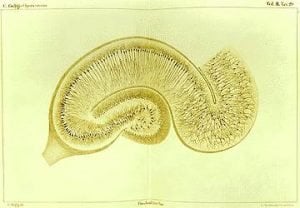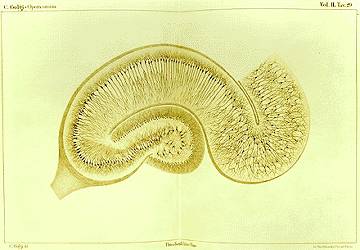Stanford scientists have developed a system for observing real-time brain activity in a live mouse. The device could prove useful in studying new treatments for neurodegenerative diseases, such as Alzheimer’s.
If you want to read a mouse’s mind, it takes some fluorescent protein and a tiny microscope implanted in the rodent’s head.
Stanford scientists have demonstrated a technique for observing hundreds of neurons firing in the brain of a live mouse, in real time, and have linked that activity to long-term information storage. The unprecedented work could provide a useful tool for studying new therapies for neurodegenerative diseases such as Alzheimer’s.
The researchers first used a gene therapy approach to cause the mouse’s neurons to express a green fluorescent protein that was engineered to be sensitive to the presence of calcium ions. When a neuron fires, the cell naturally floods with calcium ions. Calcium stimulates the protein, causing the entire cell to fluoresce bright green.

A tiny microscope implanted just above the mouse’s hippocampus, a part of the brain that is critical for spatial and episodic memory, captures the light of roughly 700 neurons. The microscope is connected to a camera chip, which sends a digital version of the image to a computer screen.
The computer then displays near real-time video of the mouse’s brain activity as a mouse runs around a small enclosure, which the researchers call an arena.
The neuronal firings look like tiny green fireworks, randomly bursting against a black background, but the scientists have deciphered clear patterns in the chaos.
“We can literally figure out where the mouse is in the arena by looking at these lights,” said Mark Schnitzer, an associate professor of biology and of applied physics and the senior author on the paper, published in the journal Nature Neuroscience.
When a mouse is scratching at the wall in a certain area of the arena, a specific neuron will fire and flash green. When the mouse scampers to a different area, the light from the first neuron fades and a new cell sparks up.
“The hippocampus is very sensitive to where the animal is in its environment, and different cells respond to different parts of the arena,” Schnitzer said. “Imagine walking around your office. Some of the neurons in your hippocampus light up when you’re near your desk, and others fire when you’re near your chair. This is how your brain makes a representative map of a space.”
The group has found that a mouse’s neurons fire in the same patterns even when a month has passed between experiments. “The ability to come back and observe the same cells is very important for studying progressive brain diseases,” Schnitzer said.
For example, if a particular neuron in a test mouse stops functioning, as a result of normal neuronal death or a neurodegenerative disease, researchers could apply an experimental therapeutic agent and then expose the mouse to the same stimuli to see if the neuron’s function returns.
Although the technology can’t be used on humans, mouse models are a common starting point for new therapies for human neurodegenerative diseases, and Schnitzer believes the system could be a very useful tool in evaluating pre-clinical research.
Notes about this neuroscience research
The work was published in the online edition of Nature Neuroscience. The researchers have formed a company to manufacture and sell the device.
Written by Bjorn Carey
Contact: Bjorn Carey – Stanford University
Source: Stanford University press release
Image Source: The image “Golgi Hippocampus” is available via Wikimedia Commons and licensed as public domain.
Video Source: The video, “Scientists Read a Mouse’s Mind” is available via Stanford University’s YouTube page.
Original Research: Abstract for “Long-term dynamics of CA1 hippocampal place codes” by Yaniv Ziv, Laurie D Burns, Eric D Cocker, Elizabeth O Hamel, Kunal K Ghosh, Lacey J Kitch, Abbas El Gamal and Mark J Schnitzer in Nature Neuroscience. Published online February 10 2013 doi:10.1038/nn.3329







